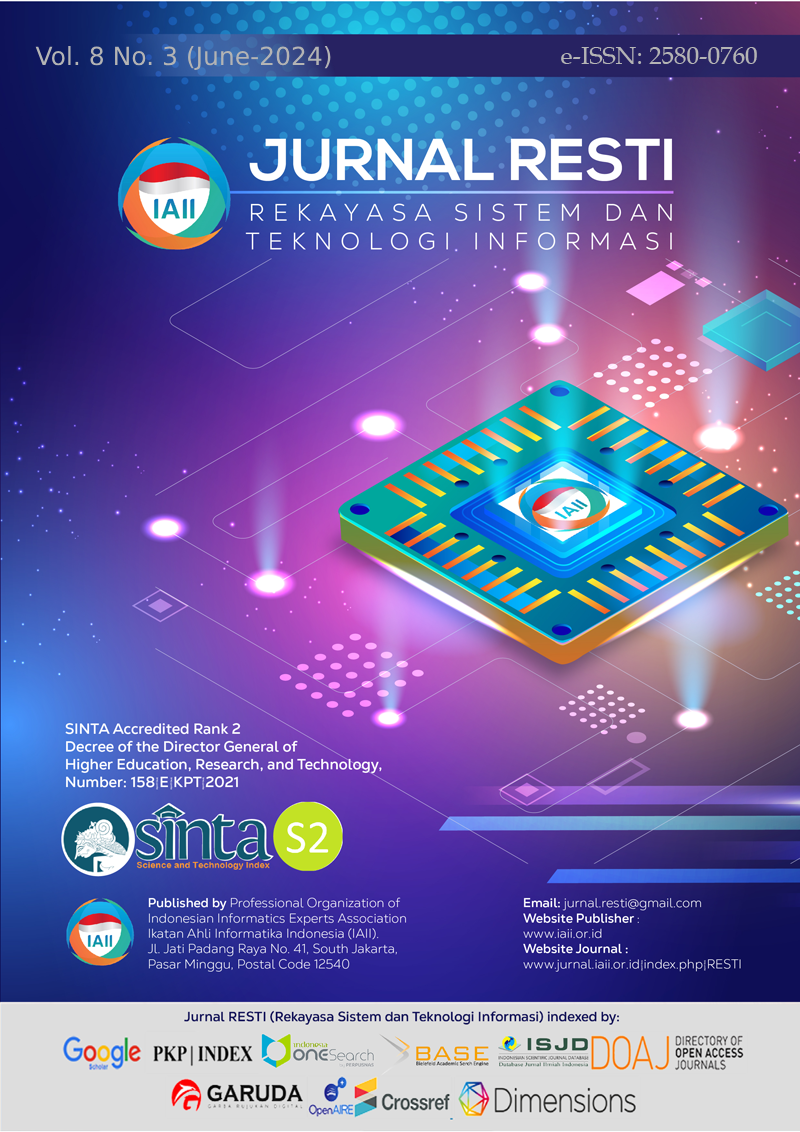GLCM-Based Feature Extraction for Alpha Matting on Natural Images
Abstract
The main objective of this research is to determine the optimal threshold value in the unknown region in the alpha-matting operation of natural images. Alpha-mating serves to draw matte from the image used in segmentation. The alpha value is very influential on the quality of segmentation which is determined by the level of threshold value accuracy. The determination of the threshold begins by breaking the grayscale image into several sub-images using Region of Interest (RoI). Each sub-image was extracted using the Gray Level Co-occurrence Matrix (GLCM) considered by the parameters of contrast, energy, and entropy at angles of 0°, 45°, 90°, and 135 °. Each feature results in extractions, which are then averaged and normalized in each sub-image. The value is determined as the local threshold value used in the alpha matting operation. Experiments were carried out on 12 natural images from the image-mating dataset to evaluate the performance of the proposed algorithm. The increase in accuracy shows up to 63% by the measurements of experiments, compared to the calculation of adaptive threshold by using the fuzzy CMs Algorithm.
Downloads
References
H. Li and K. N. Ngan, “Automatic video segmentation and tracking for content-based applications,” IEEE Commun. Mag., vol. 45, no. 1, pp. 27–33, 2007, doi: 10.1109/MCOM.2007.284535.
Y. Tsaig and A. Averbuch, “Automatic segmentation of moving objects in video sequences: a region labeling approach,” IEEE Trans. Circuits Syst. Video Technol., vol. 12, no. 7, pp. 597–612, 2002, doi: 10.1109/TCSVT.2002.800513.
A. Bovik, Handbook of Image and Video Processing. 2005. doi: 10.1016/B978-0-12-119792-6.X5062-1.
R. S. Basuki, M. Hariadi, and R. A. Pramunendar, “Fuzzy C-Means Algorithm for Adaptive Threshold on Alpha Matting,” Int. Conf. Inf. Technol. Electr. Eng., no. July, pp. 177–180, 2012.
T. K. Porter and T. Duff, “Compositing digital images,” Proc. 11th Annu. Conf. Comput. Graph. Interact. Tech., 1984, [Online]. Available: https://api.semanticscholar.org/CorpusID:18663039
H. Kardan, A. Rajaei, and H. kardan moghaddam, “Marble Slabs Classification System Based on Image Processing (Ark Marble Mine in Birjand),” Civ. Eng. J., vol. 4, p. 107, Feb. 2018, doi: 10.28991/cej-030972.
J. Wang and M. F. Cohen, “Optimized Color Sampling for Robust Matting,” in 2007 IEEE Conference on Computer Vision and Pattern Recognition, 2007, pp. 1–8. doi: 10.1109/CVPR.2007.383006.
N. Apostoloff and A. Fitzgibbon, “Bayesian video matting using learnt image priors,” in Proceedings of the 2004 IEEE Computer Society Conference on Computer Vision and Pattern Recognition, 2004. CVPR 2004., 2004, pp. I–I. doi: 10.1109/CVPR.2004.1315061.
R. S. Basuki, M. Hariadi, E. M. Yuniarno, and M. H. Purnomo, “Spectral-based temporal-constraint estimation for semi-automatic video object segmentation,” Int. Rev. Comput. Softw., vol. 10, no. 9, pp. 959–965, 2015, doi: 10.15866/irecos.v10i9.7542.
J. Sun, J. Jia, C.-K. Tang, and H.-Y. Shum, “Poisson matting,” ACM Trans. Graph., vol. 23, pp. 315–321, Aug. 2004, doi: 10.1145/1015706.1015721.
Y.-Y. Chuang, A. Agarwala, B. Curless, D. Salesin, and R. Szeliski, “Video Matting of Complex Scenes,” ACM Trans. Graph., vol. 21, Mar. 2004, doi: 10.1145/566570.566572.
Y.-Y. Chuang, B. Curless, D. H. Salesin, and R. Szeliski, “A Bayesian approach to digital matting,” in Proceedings of the 2001 IEEE Computer Society Conference on Computer Vision and Pattern Recognition. CVPR 2001, 2001, pp. II–II. doi: 10.1109/CVPR.2001.990970.
M. A. Ruzon and C. Tomasi, “Alpha estimation in natural images,” Proc. IEEE Comput. Soc. Conf. Comput. Vis. Pattern Recognit., vol. 1, no. July, pp. 18–25, 2000, doi: 10.1109/cvpr.2000.855793.
H. Liu, L. Ma, X. Cai, Z. Chen, and Y. Shen, “A closed-form solution to video matting of natural snow,” Inf. Process. Lett., vol. 109, no. 18, pp. 1097–1104, 2009, doi: https://doi.org/10.1016/j.ipl.2009.07.005.
A. Levin, D. Lischinski, and Y. Weiss, “A closed-form solution to natural image matting,” IEEE Trans. Pattern Anal. Mach. Intell., vol. 30, no. 2, pp. 228–242, 2008, doi: 10.1109/TPAMI.2007.1177.
R. Basuki, M. A. Soeleman, R. Pramunendar, A. Yogananti, and C. Supriyanto, “Video object segmentation applying spectral analysis and background subtraction,” J. Theor. Appl. Inf. Technol., vol. 72, pp. 208–214, Jan. 2015.
H. R. Rana and S. Kumar, “Color Tree Image Extraction using KNN Matting,” Int. J. Adv. Res. Comput. Sci. Manag. Stud., vol. 2, no. 2, pp. 57–62, 2014, [Online]. Available: https://issuu.com/ijitce/docs/ijitce_july2020
H. J. Vala and A. Baxi, “A Review on Otsu Image Segmentation Algorithm,” 2013. [Online]. Available: https://api.semanticscholar.org/CorpusID:62421994
N. Zayed and H. Elnemr, “Statistical Analysis of Haralick Texture Features to Discriminate Lung Abnormalities,” Int. J. Biomed. Imaging, vol. 2015, pp. 1–7, Oct. 2015, doi: 10.1155/2015/267807.
G. R. Jothilakshmi, R. J. Christilda, A. Raaza, Y. SreenivasaVarma, and V. Rajendran, “Extracting region of interest using distinct block processing method in sono-mammogram images,” in 2017 International Conference on Computer, Communication and Signal Processing (ICCCSP), 2017, pp. 1–7. doi: 10.1109/ICCCSP.2017.7944091.
M. M. Mokji and S. A. R. A. Bakar, “Adaptive Thresholding Based on Co-occurrence Matrix Edge Information,” in First Asia International Conference on Modelling & Simulation (AMS’07), 2007, pp. 444–450. doi: 10.1109/AMS.2007.8.
A. Levin, A. Rav-Acha, and D. Lischinski, “Spectral matting,” IEEE Trans. Pattern Anal. Mach. Intell., vol. 30, no. 10, pp. 1699–1712, 2008, doi: 10.1109/TPAMI.2008.168.
R. S. Basuki, A. Soeleman, M. Hariadi, M. H. Purnomo, R. A. Pramunendar, and A. F. Yogananti, “SPECTRAL-BASED VIDEO OBJECT SEGMENTATION USING ALPHA MATTING AND BACKGROUND SUBTRACTION,” 2014. [Online]. Available: https://api.semanticscholar.org/CorpusID:41462397
Copyright (c) 2024 Jurnal RESTI (Rekayasa Sistem dan Teknologi Informasi)

This work is licensed under a Creative Commons Attribution 4.0 International License.
Copyright in each article belongs to the author
- The author acknowledges that the RESTI Journal (System Engineering and Information Technology) is the first publisher to publish with a license Creative Commons Attribution 4.0 International License.
- Authors can enter writing separately, arrange the non-exclusive distribution of manuscripts that have been published in this journal into other versions (eg sent to the author's institutional repository, publication in a book, etc.), by acknowledging that the manuscript has been published for the first time in the RESTI (Rekayasa Sistem dan Teknologi Informasi) journal ;







